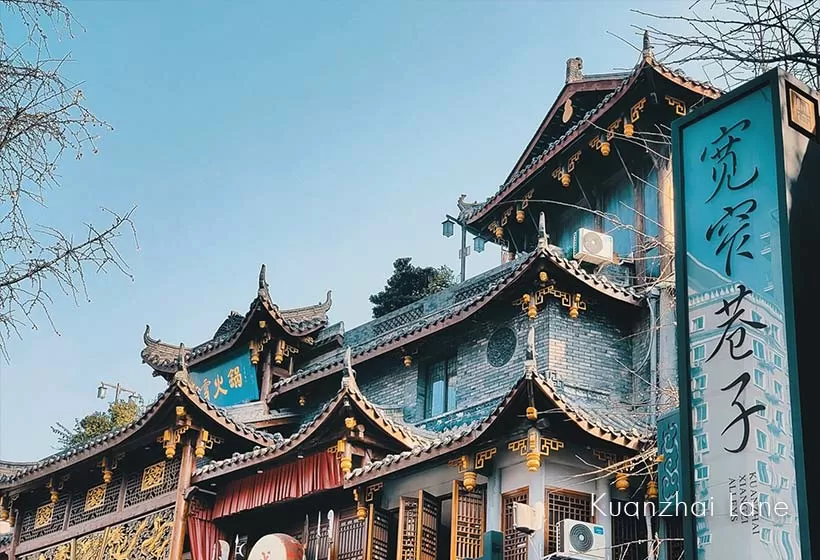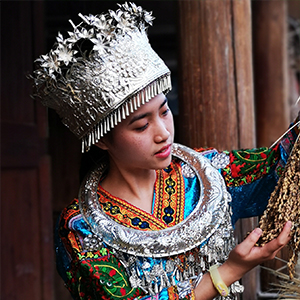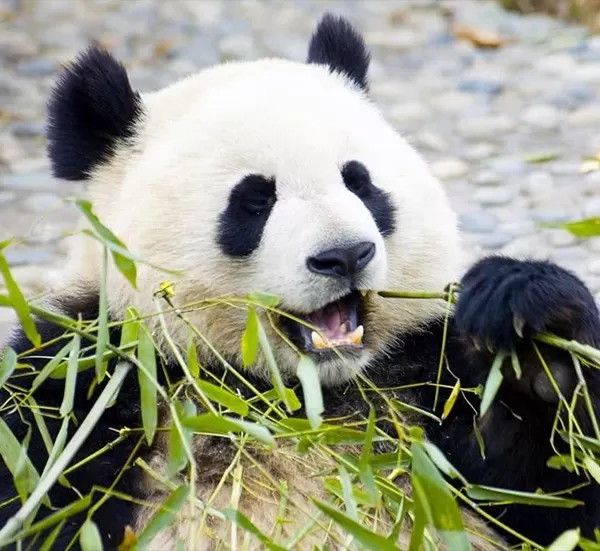Top Chengdu attractions and best sightseeing
Top 1: Chengdu Research Base of Giant Panda Breeding
Chengdu is the hometown of giant pandas, and the Chengdu Research Base of Giant Panda Breeding is located in Futou Mountain in the northern suburbs of the city, covering an area of 3.07 square kilometers. It is home to the largest ex-situ conservation population of captive giant pandas in the world and is a world-renowned non-profit research and breeding facility dedicated to the conservation, education, and breeding of giant pandas and other endangered species. The base also aims to promote public awareness and engagement in wildlife protection and environmental conservation.
The base was established in 1987. As of 2023, the panda population at the base has grown to 239. It is a must-visit attraction for panda lovers and anyone seeking a unique travel experience in Chengdu.
The panda enclosures here are cleverly integrated into the natural environment, providing a comfortable living space for the giant pandas. Visitors can not only get up close to these adorable creatures but also capture their heart-melting moments with a camera. Major highlights include the Giant Panda Museum, the Panda Nursery, the Panda Villas, the Panda Tower, and the Red Panda Activity Area.
Recommended Route:
South Gate → Sub-adult Panda Villas → Juvenile Panda Villas → Sunshine Nursery House → Moonlight Nursery House → Panda Villa No. 2 → Red Panda Nursery → Red Panda Activity Area No. 2 → Giant Panda House No. 14 → Giant Panda Museum → South Gate.
If you want to save time while covering the entire route, you can also take the sightseeing shuttle bus within the panda base.
Tips:
- 1.The best time to see pandas is in the morning, especially between 7:30 AM and 10:00 AM, when they are most active and playful. Pandas usually eat twice a day, and after feeding, they tend to sleep for 2 to 4 hours. Autumn is the best season to see panda cubs, as most are born between June and August—a truly adorable sight not to be missed!
- 2. Do not feed the pandas: The base provides a specialized diet for the giant pandas, so visitors are not allowed to feed them.
- 3. Keep quiet during your visit: Please remain quiet while touring, and do not use flash when taking photos, as it may startle the pandas.
- 4. Museum and tower closure: The Giant Panda Museum is closed on Mondays, and the Panda Tower is closed for maintenance on Tuesdays—except during public holidays.
- Address: No. 1375, Waibei Panda Avenue, Chenghua District, Chengdu
- Open Hours: 07:30 AM – 6:00 PM
- Tour Length: 2-4 hours
Top 2: Sanxingdui Museum
Sanxingdui Museum is a museum located in Guanghan, Sichuan province, China, dedicated to preserving and showcasing the archaeological discoveries from the Sanxingdui archaeological site. The site is considered one of the most important archaeological finds in the 20th century and has shed light on a previously unknown ancient civilization in China. The museum covers an area of over 7,000 square meters and displays more than 1,000 artifacts, including bronze masks, jade objects, pottery vessels, and gold pieces, dating back to the Shu kingdom during the Bronze Age (approximately 3,000 to 5,000 years ago).
The highlights of the museum include the iconic bronze masks, which are over 3,000 years old and have striking and mysterious features, as well as the bronze tree, which is over 4 meters tall and adorned with intricate designs and animals. The museum also provides visitors with interactive exhibits and multimedia displays to enhance their understanding and appreciation of the ancient Shu civilization. Sanxingdui Museum is a must-visit destination for those interested in history, archaeology, and ancient Chinese culture.
- Address: No. 133, Xi'an Road, Guanghan City, Sichuan Province, 38 kilometers from Chengdu.
- Open Hours: 8:30 AM – 6:30 PM
- Tour Length: 3-5 hours
Top 3:People’s Park
People’s Park, formerly known as Shaocheng Park, is located on Shaocheng Road near Citang Street. Established in 1911, it boasts a history of over 114 years and holds the distinction of being Sichuan’s first public garden and Chengdu’s earliest urban park. The park is home to several scenic spots, including Jinshuixi Stream, Orchid Garden, Bonsai Garden, and the famous Heming Teahouse. Its exquisite landscape features traditional gardens, bamboo groves, winding corridors, a gourd-shaped lake, ancient pavilions, and calligraphy stone inscriptions—all offering a peaceful escape from the city's hustle and bustle.
It is a popular spot among locals, who come here for exercise, leisurely strolls, socializing, traditional ear-cleaning services, and even matchmaking at the park’s well-known “marriage corner.” The renowned Heming Teahouse provides a relaxing venue for both residents and tourists to enjoy a cup of tea and unwind. On occasion, visitors can also enjoy traditional Sichuan opera face-changing performances and kung fu tea shows.
- Address: No. 9, Citang Street, Qingyang District, Chengdu City, Sichuan Province
- Open Hours: 6:00 AM – 10:30 PM
- Tour Length: 1-2 hours
Top 4:Dujiangyan Irrigation System
Dujiangyan, known as the “origin of the world’s hydraulic culture,” is a UNESCO World Heritage Site located in the western part of Dujiangyan City, Chengdu, Sichuan Province. Built on the Minjiang River in the late Warring States period (around 276–251 BCE) by Li Bing, the governor of Shu Prefecture under King Zhaoxiang of Qin, the system reflects ancient China’s remarkable ingenuity in water management. Drawing on the experience of earlier flood control efforts, Li Bing mobilized local people to construct the project, which consists of three main components: the Fish Mouth Levee (which splits the river), the Feisha Weir (a flood overflow structure), and the Bottle-Neck Channel (the intake for the inner river).
Dujiangyan stands as the world’s oldest and only surviving large-scale water conservancy project characterized by dam-free water diversion. Remarkably enduring for over two thousand years, it fully utilizes the natural terrain to achieve dam-free diversion and gravity-fed irrigation. Its integrated system—combining levee protection, water division, flood discharge, sediment removal, and flow control—works in harmony to ensure a continuous supply of water. This ingenious design has supported the development of agriculture, industry, and urban life in the region for centuries, and remains a vital source of water for the Chengdu Plain to this day.
- Address: Park Road, Dujiangyan City, Chengdu City, Sichuan Province
- Open Hours: 8:00 AM – 6:00 PM
- Tour Length: 4-5 hours
Top 5:Wenshu Monastery
Wenshu Monastery is a sacred Buddhist site that combines spiritual practice, classical gardens, ancient architecture, pilgrimage, sightseeing, and religious study. Originally built during the Sui Dynasty, this historic temple boasts a history of over 1,400 years and sits quietly in the heart of bustling Chengdu, tucked away on Hongqiang Alley in Jinjiang District. As the largest Buddhist temple within the city, Wenshu Monastery holds great cultural and religious significance. Even Emperor Kangxi once bestowed his calligraphy upon it, a testament to its revered status. It is a tranquil sanctuary amidst the urban energy, inviting visitors to explore its spiritual depth and timeless beauty.
The monastery features a traditional wooden architecture. Along its central axis stand a series of grand and majestic halls, including the Hall of Heavenly Kings, the Hall of the Three Bodhisattvas, the Mahavira Hall, the Dharma Hall, the Sutra Library, and the Manjushri Pavilion. Altogether, the temple houses over 300 statues of Buddhas and bodhisattvas. A serene pond used for releasing animals back to nature shimmers with clear water, while the incense garden, tea garden, and surrounding bamboo groves create a tranquil setting perfect for experiencing Zen tea culture. The monastery regularly hosts meditation retreats, Dharma talks, and other spiritual events that visitors can register to join. On the 1st and 15th days of each lunar month and on Buddha’s birthday, grand blessing ceremonies are held, welcoming all who wish to take part.
- Address: No. 66, Wenshuyuan Street, Qingyang District, Chengdu, Sichuan Province
- Open Hours: 8:00 AM – 5:00 PM
- Tour Length: 1-2 hours
Top 6:Wuhou Temple (Wu Hou Shrine Temple of Marquis)
Wuhou Temple, also known as the Temple of Marquis Wu, is a famous historical site located in Chengdu, Sichuan province, China. The temple is dedicated to Zhuge Liang, a renowned statesman, military strategist, and inventor who lived during the Three Kingdoms period (220-280 CE). Zhuge Liang, also known as the Marquis Wu, is respected as a symbol of wisdom and integrity in Chinese culture. The temple complex covers an area of over 37,000 square meters and includes several halls, pavilions, and gardens.
Visitors can admire the beautiful architecture and artwork of the temple, including the statues of Zhuge Liang and his contemporaries, as well as learn about the history and culture of the Three Kingdoms period. Wuhou Temple is a popular destination for tourists and locals alike and has been designated as a National AAAA Tourist Attraction in China.
- Address: No. 231, Wuhouci Street, Wuhou District, Chengdu, Sichuan Province
- Open Hours: 9:00 AM – 6:00 PM
- Tour Length: 1-2 hours
Top 7:Jinsha Museum
The Jinsha Museum was built on the site of the Jinsha archaeological site. Strolling along the elevated walkways of the site, visitors can get a close-up look at an actual excavation area, where the profound sense of history leaves a lasting impression. Discovered in 2001, the Jinsha Site was once the capital of the ancient Shu Kingdom. It includes the foundations of large buildings, ceremonial areas, residential quarters, and a large cemetery. More than 6,000 precious artifacts have been unearthed here, including gold, bronze, jade, stone, ivory, and lacquerware, along with tens of thousands of pottery shards, tons of ivory, and thousands of wild boar tusks and deer antlers.
The Jinsha Site dates slightly later than Sanxingdui, which is why many of the artifacts on display are more refined in craftsmanship. One of the museum’s most prized treasures is the Gold Sun and Immortal Birds Ornament—a delicately crafted gold foil just 0.02 cm thick. The center of the ornament is hollow, surrounded by twelve jagged rays spiraling clockwise to represent the sun. Encircling this are four identical birds flying counterclockwise, giving rise to the piece’s name. In 2005,it was selected as the logo of Chinese cultural heritage. This exquisite artifact reflects the advanced skills of ancient craftsmen and their deep understanding of nature.
Other notable items include small bronze standing figures and a large golden mask from the Shang and Zhou dynasties, along with ancient jade pieces and various ceramics. These cultural relics hold immense historical, artistic, and scientific value, serving as vital materials for the study of ancient history and civilization.
- Address: The Jinsha Site Museum is located at No. 2 Jinsha Site Road, Qingyang District, Chengdu
- Open Hours: 9:00 AM – 6:00 PM
- Tour Length: 2-3 hours
Top 8:Qingcheng Shan
Qingcheng Shan (Mount Qingcheng), with its lush greenery and layered peaks, is praised as a “natural oxygen bar” and a breath of fresh air for nature lovers. Located in southwest of Dujiangyan city and about 68 kilometers from Chengdu, it is one of the birthplaces of Taoism in China and a UNESCO World Heritage Site.
Renowned for both its natural beauty and rich cultural heritage, Mount Qingcheng is a national 5A-level scenic attraction, a protected cultural relic site, and a key national scenic area. It is also a favorite destination for hiking enthusiasts, with two main areas to explore—the Front Mountain, which is more accessible and filled with cultural landmarks, and the more tranquil and pristine Back Mountain, ideal for those seeking a deeper connection with nature.
- Address: Qingchengshan Road, Qingchengshan Town, Dujiangyan City, Chengdu City, Sichuan Province
- Open Hours: 8:30 AM – 5:00 PM
- Tour Length: 2-4 hours
Top 9:Pedestrian Streets
To truly understand a city, you must start with its pedestrian streets—Chunxi Road, Jinli Ancient Street and Kuanzhai Alley perfectly embody the charm of Chengdu. These two iconic destinations not only preserve the city’s rich history and cultural heritage, but also stand as unique urban landscapes in the heart of the modern metropolis.
Chunxi Road is Chengdu’s most iconic shopping street, bustling with international brands, local boutiques, trendy cafés, and vibrant street life. The 3D naked-eye panda on the exterior wall of the IFS (International Financial Center) attracts tens of thousands of visitors daily and you can snap photos with the iconic “climbing panda.” Just steps away is Taikoo Li, where ancient temple-style architecture houses luxury global brands, seamlessly blending with the adjacent Daci Temple, a centuries-old cultural landmark that brings together modern fashion and traditional heritage in perfect harmony.
Jinli Ancient Street, located right next to Wuhou Shrine, is often praised as the “Chengdu version of Riverside Scene at Qingming Festival” and “the First Street of Western Shu.” Its architecture, inspired by the late Qing Dynasty, features intricately designed buildings set against winding courtyards, narrow alleys, serene watersides, lotus ponds, and stone bridges. The street is adorned with rows of traditional red lanterns, creating a beautiful, nostalgic atmosphere—especially at night when the lanterns are lit, casting glowing reflections on the water and immersing visitors in a uniquely poetic ambiance full of joy and wonder.
Kuanzhai Alley is made up of three parallel historic alleys—Kuan (Wide) Alley, Zhai (Narrow) Alley, and Jing (Well) Alley—and the surrounding courtyard residences. Together, they trace the urban fabric of old Chengdu and preserve the traditional lifestyle of its residents. Here, you can feel the authentic charm of local daily life, savor famous Chengdu snacks, explore diverse boutique shops and cultural souvenirs, and experience the laid-back rhythm of the city. It’s a place where the spirit of “Old Chengdu” lives on, right in the heart of a bustling modern city.
- Open Hours: All day
- Tour Length: 1-3 hours
Top10:Huanglongxi Ancient Town
Huanglongxi Ancient Town like a gem hidden outside Chengdu’s urban area, with a rich history spanning over 1,700 years. The town is composed of one lake, two rivers, three temples, seven streets, and nine alleys, with 31,200 square meters of traditional architecture still well preserved. Recognized as a National Historic and Cultural Town of China, Huanglongxi is known for its charming Ming and Qing-style residences, featuring distinctive architectural elements such as gray-tiled roofs, wooden beam structures, bamboo-and-mud walls, and fireproof side walls on some buildings.
The town boasts ten famed ancient sights—including old streets, temples, trees, residences, docks, Buddhist caves, irrigation sites, yamen (government offices), folk traditions, and cliff tombs—that together reflect its historical and cultural richness. Visitors can savor local specialties like the famous “One Noodle” and Huanglongxi grilled fish, relax in traditional teahouses, and immerse themselves in the town’s tranquil, slow-paced lifestyle.
The ancient town is also home to two remarkable forms of intangible cultural heritage: the nationally recognized Fire Dragon Dance and the provincially listed Fuhe Haos, a traditional form of folk singing once used by boatmen on the Chengdu Plain to coordinate movement, boost morale, and express emotion while hauling boats. These living traditions infuse the town with a unique cultural charm, offering visitors a deeper glimpse into its vibrant heritage.
- Address: No. 70, Huangjin Road, Huanglongxi Town, Shuangliu District, Chengdu City, Sichuan Province
- Open Hours: All day
- Tour Length: 2-4 hours
Must-visit attractions near Chengdu:
Jiuzhaigou National Park: or "Valley of Nine Villages," is a UNESCO World Heritage Site renowned for its otherworldly beauty. Jiuzhaigou National Park is located in Zhangzha Town, Jiuzhaigou County, Aba Tibetan and Qiang Autonomous Prefecture, Sichuan Province. It is 450 kilometers south of Chengdu, this nature reserve is famous for its crystal-clear turquoise lakes, multi-tiered waterfalls, snow-capped peaks, and colorful forests that change with the seasons. The valley is also home to Tibetan villages, adding rich cultural charm to the stunning natural scenery. It’s like stepping into a fairyland. It is regarded as ‘sacred mountain and holy water’ by local Tibetan compatriots, and foreign tourists regard it as a fairy tale world.
Huanglong National Park: Huanglong, meaning “Yellow Dragon,” is named after its golden limestone formations that resemble a dragon winding through the mountains. Also, a UNESCO World Heritage Site, it lies about 100 kilometers from Jiuzhaigou. Famous for its vibrant travertine pools, snowcapped peaks, lush valleys, and rich biodiversity, Huanglong offers breathtaking views at high altitudes. The colorful calcified ponds shimmer in the sunlight, earning it the nickname “Fairyland on Earth.” Once you visit Huanglong, you’ll be enchanted by its otherworldly beauty.
Leshan Giant Buddha: The world’s largest stone Buddha statue, the Leshan Giant Buddha, is carved into a cliff face overlooking the confluence of three rivers—about two hours from Chengdu. To calm the turbulent waters and protect passing boats and local communities, a monk named Haitong from Lingyun Temple initiated the construction during the Tang Dynasty. It took 90 years to complete. The Buddha sits serenely against the mountain, with a height of 71 meters—its head alone is 14.7 meters tall and 10 meters wide, featuring 1,051 hair buns and 7-meter-long ears. The Leshan Giant Buddha is not only a masterpiece of Buddhist art but also a symbol of the ingenuity and craftsmanship of the Chinese people.
Mount Emei (Emei Shan): Another UNESCO site and one of China’s four sacred Buddhist mountains, with stunning views, temples, and monkeys along the trails.
There are many tall ancient trees, beautiful waterfalls and streams, 1600 kinds of medicinal plants as well as more than 2300 kinds of animals, especially lovely monkeys. The main peak of Mount Emei - Wanfo Peak is 3099 meters above sea level. Standing on the top of the mountain, you can admire the snow-capped mountains in the west and the vast plains in the east. In addition to the scenery of the Golden Summit, there are also four peculiar landscapes on Mount Emei: sunrise, sea of clouds, Buddha's light and holy lantern. Mount Emei is lush, quiet and beautiful all year round. The landscape changes with the seasons, altitude and climate, and it is a wondrous and mysterious world.
Customize Your Unique Chengdu Tour

Alternatively, if you would like to customize your Chengdu tour, please visit our Chengdu Tour Customized Center. We assure you that you will receive a reply within 24 working hours.
Informative Articles for Your Chengdu Trip
 Jiuzhaigou Valley
Jiuzhaigou Valley- Chengdu Travel Guide: attractions, weather, food, culture, tours, etc.
- Chengdu Culture: rich and unique
- Travel itinerary: various itineraries for your reference
- Weather: the best time and seasons to visit Chengdu
- Attraction: well-selected top attractions
- Activities: Chengdu cultural immersions
- Where to Visit: top places to visit in Chengdu
- Unique Perspective: top things to do in Chengdu
- Food and Restaurants: what and where to eat while traveling in Chengdu
- Accommodation: handpicked hotels for you
- Chengdu Tours: tailor-made Tours for your reference
GREAT FAMILY CHINA TOUR
JULY 2024 We wanted to thank Grace at China Culture tour for organizing a great tour of China. We enjoyed our Beijing - Xian-Chengdu -Guilin -Yangshuo - Shanghai trip. Our local guides Bruce in Beijing, Susan in Xian, Jane in Chengdu, Mike in Guilin and Mary in Shanghai took care of us…read more details »
Teng Han L from SINGAPORE
Ready to Create a Unique Dream Travel?


